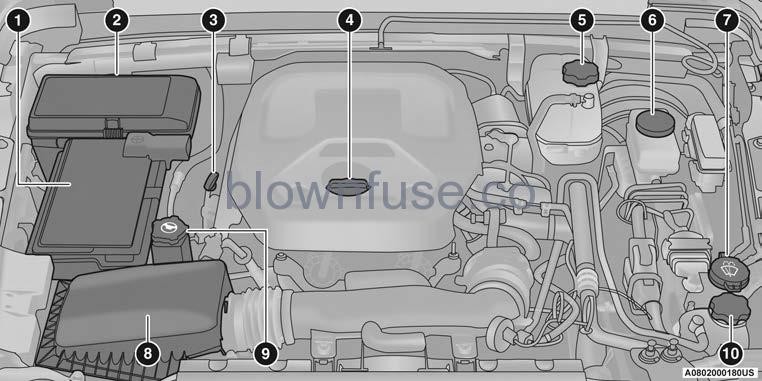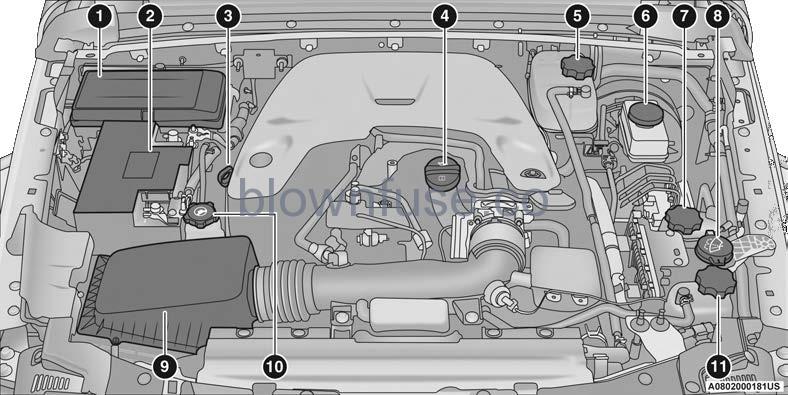2022 Jeep Wrangler ENGINE COMPARTMENT
 ENGINE COMPARTMENT
ENGINE COMPARTMENT
2.0L GASOLINE ENGINE
- Battery
- Power Distribution Center (Fuses)
- Engine Oil Dipstick
- Engine Oil Fill
- Engine Coolant Pressure Cap
- Brake Fluid Reservoir Cap
- Washer Fluid Reservoir Cap
- Engine Air Cleaner Filter
- Power Steering Reservoir Cap
- Intercooler Coolant Reservoir Cap
3.6L GASOLINE ENGINE
- Power Distribution Center (Fuses)
- Battery
- Engine Oil Dipstick
- Engine Oil Fill
- Engine Coolant Pressure Cap
- Brake Fluid Reservoir Cap
- Power Pack Unit Pressure Cap — If Equipped
- Washer Fluid Reservoir Cap
- Engine Air Cleaner Filter
- Power Steering Reservoir Cap
- Motor Generator Unit Coolant Pressure Cap— If Equipped
3.0L DIESEL ENGINE
- Battery
- Engine Oil Fill
- Engine Coolant Pressure Reservoir
- Brake Fluid Reservoir Cap
- Washer Fluid Reservoir Cap
- Power Distribution Center (Fuses)
- Power Steering Reservoir Cap
- Engine Oil Dipstick
- Engine Air Cleaner Filter
CHECKING OIL LEVEL
To ensure proper engine lubrication, the engine oil must be maintained at the correct level. Check the oil level at regular intervals, such as at every fuel stop. The best time to check the engine oil level is about five minutes after a fully warmed-up engine is shut off. Checking the oil while the vehicle is on level ground will improve the accuracy of the oil level readings. There are four possible dipstick types:
- Crosshatched zone.
- Crosshatched zone marked SAFE.
- Crosshatched zone marked with MIN at the low end of the range and MAX at the high end of the range.
- Crosshatched zone marked with dimples at the MIN and the MAX ends of the range.
NOTE
Always maintain the oil level within the crosshatch markings on the dipstick.
NOTE
Use care when filling under hood fluids such as engine oil, washer fluid, antifreeze, etc., to minimize spillage onto the top of the engine. Any excess fluid that is spilled onto the top of the engine should be removed using compressed air or an absorbent cloth. Adding 1 quart (1 liter) of oil when the reading is at the low end of the dipstick range will raise the oil level to the high end of the range marking.
CAUTION
Overfilling or underfilling the crankcase will cause aeration or loss of oil pressure. This could damage your engine.
ADDING WASHER FLUID
- The fluid reservoir for the windshield washers and the rear window washer (if equipped) is shared. The fluid reservoir is located in the engine compartment. Be sure to check the fluid level at regular intervals. Fill the reservoir with windshield washer solvent only (not radiator antifreeze). When refilling the washer fluid reservoir, take some washer fluid and apply it to a cloth or towel and wipe clean the wiper blades; this will help blade performance.
- To prevent freeze-up of your windshield washer system in cold weather, select a solution or mixture that meets or exceeds the temperature range of your climate. This rating information can be found on most washer fluid containers.
NOTE
Use care when filling under hood fluids such as engine oil, washer fluid, antifreeze, etc., to minimize spillage onto the top of the engine. Any excess fluid that is spilled onto the top of the engine should be removed using compressed air or an absorbent cloth.
WARNING
Commercial windshield washer solvents are flammable. They could ignite and burn you. Care must be exercised when filling or working around the washer solution.
MAINTENANCE-FREE BATTERY
Your vehicle is equipped with a maintenance-free battery. You will never have to add water, and periodic maintenance is not required.
WARNING
- Battery fluid is a corrosive acid solution and can burn or even blind you. Do not allow battery fluid to contact your eyes, skin, or clothing. Do not lean over a battery when attaching clamps. If acid splashes in the eyes or on the skin, flush the area immediately with large amounts of water Ú page 338.
- Battery gas is flammable and explosive. Keep flame or sparks away from the battery. Do not use a booster battery or any other booster source with an output greater than 12 Volts. Do not allow cable clamps to touch each other.
- Battery posts, terminals, and related accessories contain lead and lead compounds. Wash hands after handling.
- Vehicles with the Stop/Start system will be equipped with two batteries. Both the main and the supplemental batteries must be disconnected to completely de-energize the 12 Volt electrical system.
- Serious injury or death could result if you do not disconnect both batteries. To learn how to properly disconnect, see an authorized dealer.
CAUTION
- It is essential when replacing the cables on the battery that the positive cable is attached to the positive post and the negative cable is attached to the negative post. Battery posts are marked positive (+) and negative (-) and are identified on the battery case. Cable clamps should be tight on the terminal posts and free of corrosion.
- If a “fast charger” is used while the battery is in the vehicle, disconnect both vehicles battery cables before connecting the charger to the battery. Do not use a “fast charger” to provide starting voltage.
- Vehicles with the Stop/Start system will be equipped with two batteries. Both the main and the supplemental batteries must be disconnected to completely de-energize the 12 Volt electrical system.
- If the negative battery cables are not isolated properly it can cause a potential power spike or surge in the system, resulting in damage to essential electrical components.
PRESSURE WASHING
Cleaning the engine compartment with a high-pressure washer is not recommended.
CAUTION
Precautions have been taken to safeguard all parts and connections however, the pressures generated by these machines is such that complete protection against water ingress cannot be guaranteed.

